LOCAL ANTHROPOGENIES - CONTEMPORARY COSMOGONIES
COMIC STRIP: THE QUANTAL BLANK
1905 AND LITTLE NE-HOMO
In some eras, minds breathe, meaning that representatives of the most diverse disciplines echo one another. Such is the case for 1905. Everywhere, Homo discovers the discontinuous, whilst every tradition until then had encouraged him to believe that the foundations of the world are continuous.
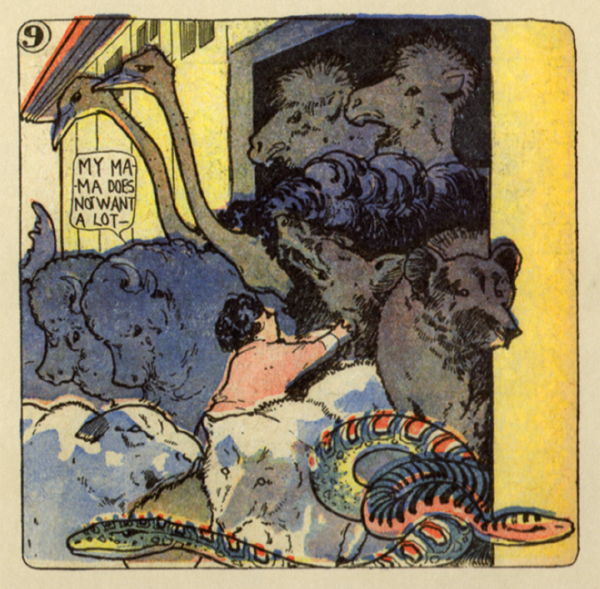
1905. Winsor Mc Cay plays with the sheets of his Dreams of the Rarebits Fiend
For centuries, stories have been told using juxtaposing images… or at least since Egypt and Memling’s Reliquary of Saint Ursula. Scenes follow one another like in the course of things. The white of images serves to sew together the steps of a history in the same general view, a followed temporality. However, here I fancied – instead of placing the frames alongside one another – piling them up, creating four-line pages, and using two columns instead of three. There is nothing to worry about here, particularly as I aligned my frames – horizontally and vertically – in such a way that the whites that separate them form lines and column in the right order. Nothing drastically new here, apart from the fact that one can see the first and last image simultaneously, and even skimming them through according to various diagonals. Yet I have the impression of standing before something completely revolutionary, almost disquieting. In this mechanism, the white between the cartoon panels is no longer there to link them together, to embrace them. It seems that it digs like hollowness
1905. Max Planck
It is unbelievable. I send an electromagnetic wave from an emitter to a receptor, and the emission and the reception do not happen continuously. It is as though ‘light’ – as we commonly say – left in grains and arrived in grains. But who ever saw a grain in a fundamental physic phenomenon? The world has always gone from cause to effect. There could not be a hole, emptiness, a no man’s land between the cause and the effect. Let’s just say that in my emitters and receptors, there is neither this je ne sais quoi of causes nor effects in the everyday sense. Nor, to conclude, space and time. All the Archimedean, Galilean, Cartesian, and Newtonian physic would only be specific cases of more general principles! It is so insane that I no longer dare speak about it to my students. They look at me very strangely since I mentioned it. However, I had taken the precaution of communicating the facts without going too much into the consequences…
1905. Winsor Mac Cay
To tell the truth about the mechanism of my Dreams of the Rarebits Fiend, it is not only the relation between the cartoon panels that is unsettling, but also their content. If I draw a person in the first cartoon panel, I can be almost certain that in the next, I will have him spin on himself by a full turn, a half turn, a quarter of a turn, a double turn, and every time this will happen instantaneously. Or I could have him instantaneously lie down, contract, fatten, and shrink. This is rather chilling, because it is devoid of continuous causality. There are no events in an everyday sense. And without events, there is no world. What frame of mind does that take us to? These are not dreams, because no dream can be as systematic. This is not a mere dawdling, because there are no musings as delirious. In English, the most appropriate (although not perfect) word would be reverie, in the etymological sense of resver, meaning being delirious. However, I would use the title dreams, because reverie is a bit scholarly in English. And because these visions have something of what we feel as we awake from a nightmare – hence a dream – following indigestion. A calm nightmare that favours something of this floating attention recommended by my contemporaries Einstein and Freud. The former because it is where he finds the solutions as he steers his boat on the Zurich Lake, the second because that is where he makes his diagnosis when he sits behind his lying patient.
1905. Albert Einstein
Our friend Planck is still very timid. He speaks as though his quanta only occurred at the instant when his electromagnetic waves emit and receive. Yet, the waves themselves are granular. I can even tell you that I’ll get my Nobel for having seen this ‘photoelectric effect’ rather than for Relativity. In fact, the constant concern of every twentieth century physicist is not so much curvatures, expansions, and dilatations that will be attributed to my relativist space-time; all this remains somehow intuitive – hence embraceable – thereby reassuring. What will keep them awake at nights are Quanta, where causal continuities will be replaced by ‘spins’, and the state measurements by states behaviours; points by strings; I can even predict that one day there will be non-commutative geometries <<<Alain Connes?>>>. In such a way that the words ‘space’, ‘time’, ‘space-time’ are harmed <<<Marc Lachièze-Rey? >>>
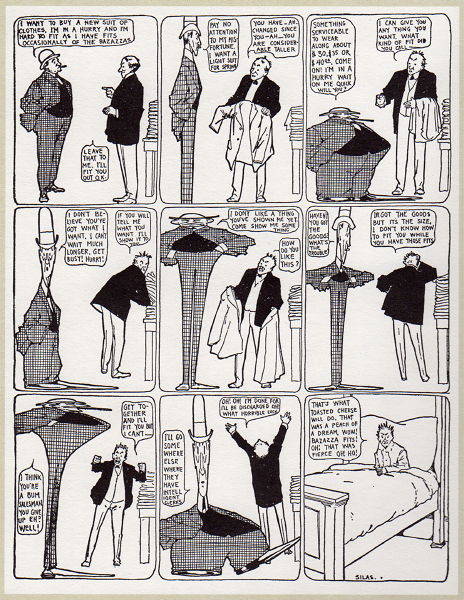
1905. Winsor Mc Cay taking a glance at the first strips of Little Nemo
Is it because of the combinatory poverty of my Dreams that I started, a little while ago, a series where a few cartoon panels of the multi-frame moved to the right and to the left, particularly at the bottom of the page? The effect of the nullification white is made even more powerful that it is everywhere. As a result, the elementary combinatory ends. Now, when I go from one cartoon panel to another, my pencil, my nib, and my paintbrush almost escape my hands to create engendering, growths, proliferations, budding; they play at Lamarck and Darwin. Organs become other organs. Lizards have feet that become feathers or wings. In such a way that lizards become fishes or birds; a rock begins to swarm with leaves; leaves remineralize into rocks. We can see that the Ancients had all the means to create ‘comic strips’, but they did not think about it. Perhaps they were ‘creationists’, not ‘evolutionists’ as we. I am often told that, in the ‘New York Tribune’s’ splendid colour print, my colours create iridescences. Normal. Iridescence is the sister of evolutionary proliferation.
1905. D'Arcy Thomson
Why is it that I so enjoy translating Aristotle’s works on animal parts (De partibus animalium)? Is it because, on every page, he guesses a logic operating the succession of embryonic stages? Sadly, he was not fond of mathematics and had not read Darwin. Whilst I might only be a modest mathematician, a modest biologist and a modest draftsman, when I see a living, I move on to other livings just by using a compass and a ruler (the only two instruments claimed by Euclid). In the general contours, but also for the details: feathers, scales, hair. All this should really be classified. In ten year’s time, I will edit a great work entitled On Growth and Form. It won’t be of any interest to the Latin – who only see law and morality – but will be incredibly appealing to the Anglo-Saxons, who are congenital biologists and evolutionists. Someone told me that a certain Mc Cay, an American cartoonist, also obtains dozens of different dinosaurs, merely following the suggestions of his irregularly superimposed cartoon panels.
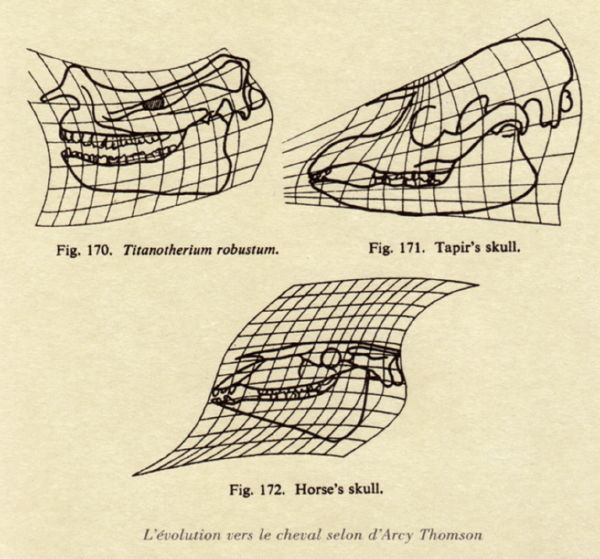
1905. Winsor Mac Cay
Tales also liven up. Characters and objects are no longer content with spinning on themselves, or to simply grow, shrink, blow-up, or slim as in Dreams. They encounter, creating real events: A enters into B and bursts it; B encompasses A, imprisons or digests it in a pocket. In 1902, Emil Fisher was awarded with the first Nobel Prize for chemistry for having shown that proteins (from the Greek proteios: of foremost importance) link to one another by key-lock effects, which allows them to anatomically build organisms and to physiologically ensure exchanges of energy and information. Key-lock effects can be found everywhere in my drawings. Hence, there would me more topology than there is geometry in my multi-frames. It is true that, already in my Dreams, the skyscrapers my hero crosses are – in a first while – well drawn according to the perspective (geometrically) that my good master Goodeson taught me. As he moves on, having become as tall as the skyscrapers, he opens and closes them as though they were petals (topologically). I am sure that one day a cartoon artist will bear the name of Moebius, after the name of this very popular topological figure obtained when one wrings the end of a ribbon by a half-turn and sticks it to the other tip, obtaining a closed band whose two faces are both outside and inside.
1905. Henri Poincaré
If you want to go to the bottom of things, geometry is all right, although topology is best. Pythagoras and Plato thought they could rebuild the Universe with circles, squares and polyhedron, Descartes with proportions. At that rate, you find a Cosmos, not the Universe. Leibniz realized that, before and beneath these measurable, equalizable figures, there is a more initial mathematic that is content with playing with the near and the far, the continuous and the discontinuous, the contiguous and the non-contiguous, the path and the non-path, and particularly the surrounding and the surrounded. Emil Fisher’s (topological) key-lock effect suffices to ensure both the carpenter’s mortice and tenon and the sexual coaptation of the living, which is very important. Of course, to fully grasp the fecundity of topology, we shall have to – after the general Topology I just discussed – edify a differential Topology, which, on the model of the crease, or ‘Riemann’s catastrophe’, explores the pleat (fold), the swallowtail, the butterfly and the three hyperbolic, elliptic, parabolic umbilici. As we see in these examples, a ‘catastrophe’ is a transformation that comprises a singularity, meaning a point in the space-time where the space-time curvature becomes infinite. In fifty years’ time, someone <<< René Thom >>> will perhaps demonstrate that there are a limited number of elementary catastrophes. I have just accounted for seven. To be continued.
1905. Winsor Mc Cay
However, if my intervals of white suggest true stories, I can sense that they are few. There are millions of possible novels and millions of different types of novels possible. The fantastic imagination still moves in Homo’s daily life, among technical and semiotic systems. There are millions of probable technical and semiotic situations. This is very different for cartoons. As it is extremely topological, its situations would be in very limited numbers, such as elementary catastrophes <<< René Thom’s seven? >>>. This would force it to the essential, even archaism. Paleontological, even when it draws current living. Seeing ‘obscure cities’ under today’s towns <<< Schuiten and Peeters ? >>>. Attentive to fundamental logics as soon as the word exists <<< Hergé, Quick et Flupke ? >>>. Speaking to ‘Humanoids’ – associated or not – more than Humans. A sort of ‘Echo of the Savanes’.
1905. Erik Satie
This year, I, unrepentant autodidact musician, have decided to follow a composition course. Not to renounce to my Morceaux en forme de poire, my Véritables préludes flasques, my Pièces à faire fuir, my Pour un chien, in which both Debussy and Ravel must have seen something since they orchestrated from it. Perhaps a certain way of topologizing music, rather than geometrizing it like Bach and Mozart. Of being even more essential because they were being simple in a succession of chords of nines. They pretend that I am as mystical as I am comical. Just like cartoons. I meditate a Socrate while reading Plato. And this is the very reason why I chose the Schola Cantorum as a school.
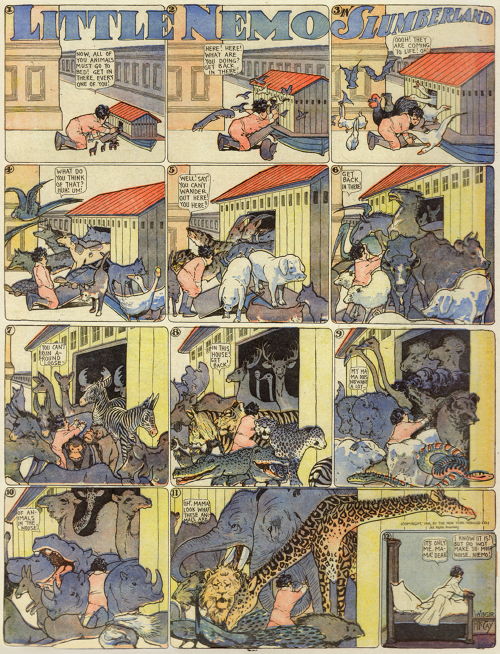
1905. Winsor Mac Cay
The status of writing is remarkable in my recent drawings. Whereas in my Dreams the narrative text is done the old way, under the drawings, therefore providing a narrative continuity, as soon as my frames move up, now the texts invade the drawings, surrounding themselves with somewhat trembled balloons and take on forms that are similar to figures. This induces a calligraphy that is more analogical than digital. Simultaneously, the tongue moves too. OOOOOHH’s, WAAAOOO’s! I see ‘smurfed smurfs smurfing smurfinesses’ in the background. As though language in turn wanted to be elementary, archetypical, stereotyped according to the day’s stereotypes. This infantile language, reporter, scientific speech or at least masses of emotive incidences that don’t mean very much at all. As though pleasing the Rousseau of the Origines du language. Of course, Satie would say that the elementary might rise to the divine, the comical to the mystical, and turn H-A-R-Z-A-K into the name of God!
1905. James Joyce
At thirty-three, you can just about see where you want to go. Telling fantastic tales using a more or less seductive language, the ‘well-written’, is not my cup of tea. On the other hand, what I do hear – perhaps because I am visually impaired – is language itself, how it determines what can be and cannot be. Under the condition that one does not exclusively stick to grammars and dictionaries, creationist, and going back up to his secret, phonosemic, evolutionary organisations whilst he still stammers, seeks himself, hesitates between three or four words, three or four phrases that are sometimes layered. We, dwellers of Dublin, at the end of Europe, we practice this art from morning to evening, blending Irish, English, Celtic, the church’s Latin, European languages that are simultaneously Germanic, Anglo-Saxon, and Roman. Among these unceasing cultural rubbings, elements appear. These grains of the language form metaphorical wholes and metonymic hollows. In 1897, the Mallarmé who wrote ‘Un coup de dé jamais n’abolira le hazard’ wanted to prove his point by placing his lines on double pages, where the reader – in order to go down from one line to another – is forced to jump from one page to the other so that the whites should ‘assume the importance, strike first (…), creating ‘prismatic subdivisions of the idea’. I will write the Ulysses of this archetypical language before a Finnegan’s Wake that is a pathetic and mystical as Satie.
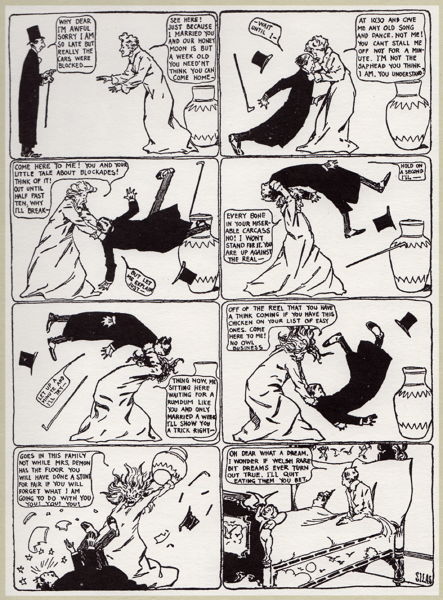
1905. Winsor Mc Cay
But where and when does it take place? In Dreams, I already spoke of reverie, of resver, of being delirious. This time, it is so confuse, so prolific, that I am led into thinking of a Slumber in a Slumberland, where all the elements, inert and living, become as connective as the neurons that Gogli captured on an image in 1902. It proliferates everywhere to the point that everything, absolutely everything, becomes possible.
1905. Sigmund Freud
I’m seriously starting to wonder whether Mc Cay’s Slumberland is not more pertinent than my famous three floors topic: the Conscious, the Preconscious, and the Unconscious. Did I not go ahead of myself when, to grasp the Unconscious, I ran to the dream, from which I made a diverted (symptomatic) accomplishment of desire? Following that course, my Unbewusste is then like an underground source, a cave or a cavern, a water boiler, or in any event a ‘place underneath’, according to the good old western topic of neo-Platotonism, Christianity, rationalism. Whilst the forest of his ‘slumber’ connects from leaf to leaf, from branch to branch, from dendrites to axons, creating innovating connections in every direction or redistributing useless or unhappy ancient connections or reaching recurrent bugs, those that will force me to postulate a death impulse to account for traumatic dreams. Of course, I have excuses. My Traumdeutung was published in 1900. Only two years later, in 1902, Golgi started colouring neurons. Then, another four years before Ramon y Cajal perfected the process to such an extent that now the central nervous system is blatant, at least in the eyes of Sherrington. Perhaps that his multi-framed drawing proved to him that, in our thoughts, there are less great vectors and great intentions than there is a swarming. Whereas I, inveterate Aristotelian, still see accomplishments of desire everywhere, therefore final causes. This can work for neurotics like my Viennese patients, who are split between contradictions of idiotypes <<< René Lavendhomme? >>> that just need to be identified to be transfigured. And if the dream was this paradoxical moment of sleep where the muscular silence allows for the wildest activations of cerebral neurons that are on vacation from their daily obligations, and that can then reorganise their too aberrant idiotypes <<<Dominique Bourn? >>>. And if the psychoanalytical cure was a daily moment of activation of idiotypes favourable to their organisation <<< Bourn et Lavendhomme ? >>>, without necessarily seeing sexuality everywhere. I would need to observe my cat’s R.E.M. (Rapid Eye Movement) whilst he sleeps. And I should also have a cup of strong coffee with my neighbour, Schumpeter. This fiery economist, aged just 22, makes a theory on the innovations through the ties of unexpected connections perceived and exploited by innovators, entrepreneurs. These concepts are not my forte, as I am haunted by the homeostatic model of a Walras <<< general economic equilibrium >>> of psychology.

1905. Winsor Mac Cay
I need to define a moving hero for my Slumberland. I’m convinced that he will be an adolescent, unless he belongs to the ‘adult age of childhood’. In any case, the essence is that he should not be a ‘Me’, capitalized à la Descartes, or a western ‘I-Me’, and particularly not a ‘I… myself’. ‘I’s’ always begin from a supposedly punctual source, a unifying idiotype, an interiority that should be maintained and warms us so well from the central pleat between the two equal pages of a manuscripts or printed codex under the unifying light of a lamp. However, in the aircraft multi-frame of cartoon (even when it is placed on a double page) there is no hearth, no anchoring point, no ‘I’. The central fold is no longer central. In a nutshell, the name of Slumberland’s hero cannot be positive. We must note how much he is a non-man, ne-homo, nemo. This reminds me, Jules Verne’s hero of Twenty Thousand Leagues under the Sea already bears that name! The difference is that to cross such a distance beneath the waters, Nemo’s captain had to be a great hero. Whilst my Nemo is lost amidst my pullulating connexions of undergrowths or neurons, and feels very small, strictly speaking drowning, lost in the slumber party of Slumberland. I will call my cartoon Little Nemo.
Post-Scriptum
Let’s admit that specific works – even those that are distinguished – do not characterize a century in an anthropological manner, but that new media penetrating and transforming spirits from instant to instant do. Therefore, the two major anthropologic revolutions of the twentieth century are probably – more than Joyce or Picasso – Photography (Talbot, 1840) and Cartoons (Mc Cay, 1905). Both are granular, quantal, digitalizing even in the analogical. They are at least as discontinuous as they are continuous. Both have the same evacuation of the ‘I’ to the benefit of an X-being. One century before philosophers realized this. Just as three centuries were required so that Plato could clearly formulate what the Grecians vases of the eighth century BC declared.
Henri Van Lier